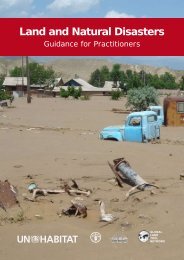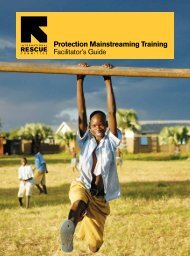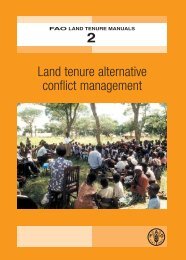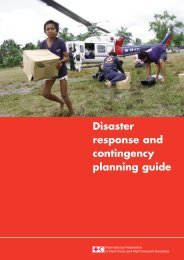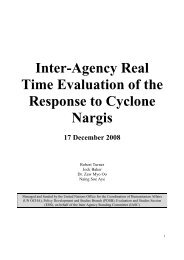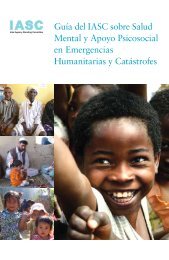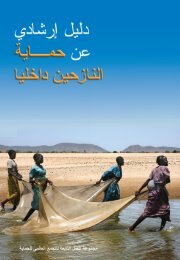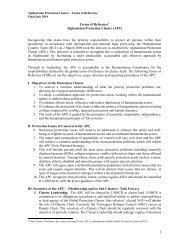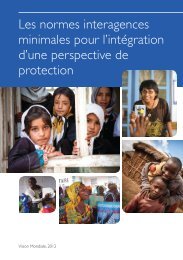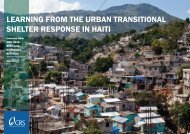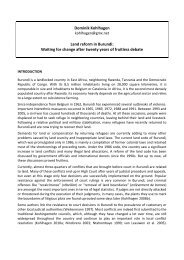Mid-Year Review of the Work Plan for Sudan 2012 - Global ...
Mid-Year Review of the Work Plan for Sudan 2012 - Global ...
Mid-Year Review of the Work Plan for Sudan 2012 - Global ...
You also want an ePaper? Increase the reach of your titles
YUMPU automatically turns print PDFs into web optimized ePapers that Google loves.
UNITED NATIONS AND PARTNERS[2] PROGRESS | [2] SECTOR NEEDS RESPONSE ANALYSISMID YEAR REVIEW | SUDAN WORK PLAN <strong>2012</strong>53TABLE OF MID-YEAR MONITORING VS. OBJECTIVESOutcomes (withcorresponding targets)Outputs (with corresponding targets)Indicators (with correspondingtargets and baseline)Achieved as mid-yearStatusObjective 1: Enhance and develop an overarching policy framework <strong>for</strong> returns, early reintegration and durable solutions.Government, UN and partnersagree to a common frameworkto respond to <strong>the</strong> needs<strong>of</strong> vulnerable IDP populationsreturning to areas <strong>of</strong> intendedsettlement and to supportdurable solutions.Include, but not limited to:- Developing standard return and early reintegrationframework at <strong>the</strong> national level.- Providing quality control on activities thatrespond to return issues in line with this policy.- Advocate with national counterparts to ensure<strong>the</strong> rights and needs <strong>of</strong> returnees are met andare consistent throughout <strong>Sudan</strong>.- Standard returns policy developedand circulated to nationalactors, UN and partners.- # monitoring and assessmentmissions <strong>for</strong> return processes.- % <strong>of</strong> successful return processes.- Advocacy pointsdeveloped on returnsand South <strong>Sudan</strong>ese in<strong>Sudan</strong>.- Contingency plandeveloped in coordinationwith OCHA on end<strong>of</strong> <strong>the</strong> transition period.- Movement plan developedto support assistplanning <strong>of</strong> organizedassisted movement.On TrackObjective 2: Provide timely and coordinated humanitarian response to vulnerable IDP populations returning to areas <strong>of</strong> intended settlement.All identified gaps and overlapsare addressed througheffective coordination andtimely in<strong>for</strong>mation sharing.IDP communities returning orintending to return to areas<strong>of</strong> settlement and supportedunder this sector responseplan receive adequate emergencyservices in one or more<strong>of</strong> <strong>the</strong> following sectors: NFIs,basic medical care, educationin emergencies WASHsupport, food assistance.Host and returning communitiesare empowered todevelop an environmentconducive to successful reintegration.Include, but not limited to:- Identification and coordination <strong>of</strong> solutions togaps and overlaps in activities and geographicalcoverage.- Multi-sector fundraising- Timely reporting and in<strong>for</strong>mation sharing.- Timely multi-sector needs assessments.- Registration <strong>of</strong> returnees.- Distribution <strong>of</strong> key life-saving materials.- Enhancing access to health care, e.g. throughmobile clinics/ambulance services, etc.- Food distributions where necessary and tied toregistration.- Settlement coordination where large numbers<strong>of</strong> returnees are stranded in one area.- Assisted transportation services <strong>for</strong> <strong>the</strong> mostvulnerable.- Data ga<strong>the</strong>ring through tracking <strong>of</strong> displacementand return movements (disaggregated bygender and age).- In<strong>for</strong>mation sharing among returnee and hostcommunities prior to, during and post returnprocesses to ensure a) returnees are able tomake in<strong>for</strong>med choices about <strong>the</strong>ir return; b)host communities are aware <strong>of</strong> <strong>the</strong> return and<strong>the</strong>ir part in it; and c) limited conflict amonghost and returnee communities over availableresources, etc.- Percentage <strong>of</strong> returnees registered.- Number <strong>of</strong> vulnerable IDPsreturning to areas <strong>of</strong> intendedsettlement identified and assessed.- Number <strong>of</strong> returnees in needreceived emergency assistance.- Number <strong>of</strong> sector coordinationmeetings held.- Number <strong>of</strong> training sessions <strong>for</strong>stakeholders on return and earlyreintegration.- Number <strong>of</strong> regular sector reportsproduced.- Number <strong>of</strong> in<strong>for</strong>mationcampaigns specifically on returnand early reintegration issues.- Number <strong>of</strong> meetings held withnational counterparts on returnspolicy and activities.- Number <strong>of</strong> actors involved inreturn planning and processes.Over 12,000 peopleprovided with food,water, sanitation andnutrition services at Kostiway station.- Over 16,400 patientsserved at Fellowship<strong>of</strong> African Relief clinic(some patients more thanonce)-13,953 returneesreceived hygiene education.- 74 returnees screened<strong>for</strong> HIV/AIDS.- 20,177 returneesprovided with NFIs (someindividuals receiveditems more than onetime, especially if <strong>the</strong>irstay was long).- 145 children providedwith <strong>the</strong>rapeutic feeding.- Over 40 returnsupdates/reportsproduced and circulated.- Over six sector coordinationmeetings held.- 12,212 people returnedfrom <strong>Sudan</strong> to South<strong>Sudan</strong> by air and train,with 2,300 transported byrail and 9,912 transportedby air.- Facilitation <strong>of</strong> medicalescort <strong>for</strong> two trainsconvoys from Khartoumto Wau and Aweil.(including midwives andSGBV specialists).- Medical escorts <strong>for</strong> airmovements <strong>for</strong> EVIs and<strong>the</strong> airlift from Kosti- 220 personal hygienekits and 150 clean deliverykits distributed toSouth <strong>Sudan</strong>ese in KostiWay Station.On Track



